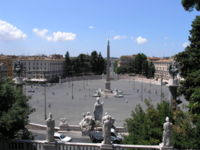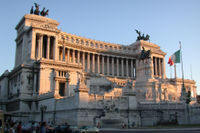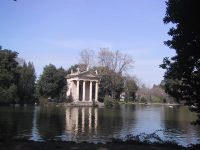|
ЦКСАНЙХИ
ЛНЦХКЮ
БЕКХЙНКЕОМШИ |
Ancient Rome
One of the symbols of Rome is the Colosseum (70-80), the largest
amphitheatre ever built in the Roman Empire. Originally capable of
seating 50,000 spectators, it was used for gladiatorial combat. The
list of the very important monuments of ancient Rome includes the
Roman Forum, the Domus Aurea, the Pantheon, the Trajan's Column, the
Trajan's Market, the Catacombs of Rome, the Circus Maximus, the
Baths of Caracalla, the Arch of Constantine, the Pyramid of Cestius,
the Bocca della Verità.

Piazza del Popolo
Renaissance and Baroque
Rome was a major world center of the Renaissance, that left a
profound mark on the city. The most impressive masterpiece of
Renaissance architecture in Rome, is the Piazza del Campidoglio by
Michelangelo, with the Palazzo Senatorio, seat of the city
government. During this period the great aristocratic families of
Rome used to build opulent dwellings as the Palazzo del Quirinale,
now seat of the President of the Republic, the Palazzo Venezia, the
Palazzo Farnese, the Palazzo Barberini, the Palazzo Chigi, now seat
of the Prime Minister, the Palazzo Spada, the Palazzo della
Cancelleria, the Villa Farnesina. Rome is also famous for her huge
and majestic squares, often adorned with obelisks, many of those
built in the XVII century. The principal squares are Piazza Navona,
Piazza di Spagna, Campo de' Fiori, Piazza Venezia, Piazza Farnese,
and Piazza della Minerva. One of the most emblematic examples of the
baroque art is the Fontana di Trevi by Nicola Salvi. Other notable
baroque palaces of XVII century are the Palazzo Madama, now seat of
the Italian Senate and the Palazzo Montecitorio, now seat of the
Chamber of Deputies of Italy.

Monument of Vittorio Emanuele II
Neoclassicism
In 1870, Rome became capital city of the new Kingdom of Italy. And
neoclassicism, a building style influenced by architecture during
Antiquity, became a predominant style in Roman buildings. In this
period many great palaces in neoclassical styles were built to host
ministries, embassies and other governing agencies. One of the
best-known symbol of Roman neoclassicism is the Monument of Vittorio
Emanuele II or "Altar of Fatherland", where the grave of the
Unknown Soldier, that represents the 650,000 Italians that fell in
World War I, is located.
Fascist architecture
The Fascist regime that ruled in Italy between 1922 and 1943
developed an most original architectural style, characterized by feast
and the research of a link with ancient Rome architecture.
The most
important fascist style site in Rome is the E.U.R. district, built
in 1935. It was originally conceived for the 1942 world exhibition,
and was called "E.42" ("Esposizione 42"). However, the world
exhibition never took place due to Italy entering the Second World
War in 1940. The most representative building of the Fascist style
at E.U.R. is the Palazzo della Civiltà Italiana (1938-1943), the
iconic design of which has been labeled the cubic or Square
Colosseum. After World War II, the Roman authorities found that they
already had a gem of an off-centre business district that other
capitals were still planning (London Docklands and La Defense in
Paris). Also the Palazzo della Farnesina, the actual seat of Italian
Foreign Ministry, was designed in 1935 in fascist style.
Villas and gardens

Villa Borghese
The center of Rome is surrounded by some large green areas and
opulent ancient villas, which are the remains of the crowns of
villas which encircled the papal city. Most of them were largely
destroyed by real estate speculation at the end of the 19th century.
The most important among the surviving ones are: Villa Borghese,
with a large landscape garden in the naturalistic 19th century
English style, containing a number of buildings, museums (see
Galleria Borghese) and attractions; Villa Ada, the largest public
landscaped park of Rome; Villa Doria Pamphili, the second largest
with an area of 1.8 km²; Villa Torlonia, a splendid example
of Art Nouveau mansion that was the Roman residence of Benito
Mussolini; Villa Albani, commissioned by Alessandro Cardinal Albani
to house his collection of antiquities and Roman sculpture, which
soon filled the casino that faced the Villa down a series of formal
parterres. |